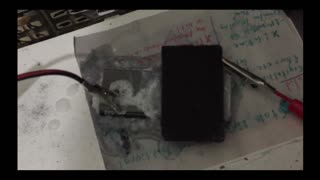Premium Only Content

Modern Moray Generator
Good day folks, Here is the progress with exploring reactive (VAR) power and what it can do at resonance. I explain the details on how to even get batteries to charge with AC.
Unlike the trolls that tell me I never post circuit diagrams. You can find the circuit diagram in on my forum at http://typeright.social/forum/showthread.php?tid=371
A memo on fine tuning:
Given that both the inductance and capacitance are 70.48 µH and 70.48 µF respectively, the LC circuit is indeed resonant at 60 Hz. To fine-tune this circuit, You can optionally incorporate a parallel vacuum capacitor for small adjustments and a series capacitor for potential impedance matching.
### Verify Resonance Frequency
- **Inductance**: (L = 70.48
- **Capacitance**: (C = 70.48
- **Resonance Frequency**: (60
- **Parallel Vacuum Capacitor**: (C should range from 0 to 3.524 µF for fine-tuning.
- **Series Capacitor for Impedance Matching**: approx 53.05 uF
*This configuration allows for fine-tuning of the LC circuit to maintain resonance at 60 Hz and achieve impedance matching if needed.
Concept
LC Resonant Circuit: Utilize the high circulating reactive power at resonance. (VAR)
Direct Battery Integration: Connect batteries in a manner that allows them to charge without disrupting the reactive power oscillations significantly.
Resistive and Inductive Loads: Use light bulbs and other inductive components to balance the load and manage current flow during different parts of the AC cycle.
Method:
Series LC Circuit with Batteries and Light Bulbs
Resonant LC Circuit:
L: Inductor
C: Capacitor
Direct Battery Charging:
Connect batteries directly into the LC circuit at points where they can charge during the positive half of the AC cycle and be protected from reverse current during the negative half.
Light Bulbs as Loads:
Use light bulbs as resistive/inductive loads to absorb power during the negative half of the cycle, thus protecting the batteries.
Practical Considerations
Voltage Levels:
Ensure the voltage levels in the LC circuit match the charging requirements of the batteries.
Current Flow Management:
The light bulbs will naturally limit the current during the negative half-cycle, preventing reverse currents from damaging the batteries.
Tuning:
Fine-tune the circuit to ensure that the LC circuit remains in resonance while effectively charging the batteries.
Testing and Safety:
Start with lower power levels to test the setup.
Monitor the temperature and performance of the batteries and light bulbs to ensure they are operating within safe limits.
Challenges and Adjustments:
Balance: Achieving the right balance between the reactive power accumulation and the load distribution is crucial.
Fine-Tuning: You may need to experiment with different configurations and component values to achieve optimal performance.
Monitoring: Continuously monitor the circuit's behavior to avoid overcharging or damaging the batteries.
By using this approach, you can tap into the reactive power of the LC circuit to charge batteries directly while using light bulbs to manage the current flow during the negative half-cycle. This should allow you to maintain the resonant condition and recover reactive power without the use of rectifiers.
-
 6:21
6:21
Joel Lagace
5 months ago $0.04 earnedHigh Power Crystal Cell
107 -
 LIVE
LIVE
Grant Stinchfield
41 minutes agoP'Nut's Execution is More About Democrat Tyranny than the Murder of an Innocent Squirrel
402 watching -
 1:01:15
1:01:15
The Dan Bongino Show
4 hours agoBeware Of Last Minute Psy-Ops! (Ep. 2364) - 11/04/2024
599K803 -

Right Side Broadcasting Network
1 day agoLIVE: President Trump Holds a Rally in Raleigh, NC - 11/4/24
163K -
 LIVE
LIVE
The Rubin Report
1 hour agoJoe Rogan Gets John Fetterman to Admit the Dark Truth of Dems Immigration Plans
7,638 watching -
 13:25
13:25
Steven Crowder
2 hours agoWe are the News Now: Election 2024 Docuseries Part 3 | Louder With Crowder
108K220 -
 LIVE
LIVE
Drew Hernandez
12 hours agoFINAL TRUMP RALLY NC, PA, PA, MI & ELECTION HOME STRETCH UPDATES
1,639 watching -
 1:44:03
1:44:03
Omar Elattar
22 hours agoThe No. 1 Productivity Doctor: How To Get More Done In 1 Week Than Most In 12 Months!
26.3K -
 LIVE
LIVE
LFA TV
15 hours agoBRINGING IT HOME! | LIVE FROM AMERICA 11.4.24 11am EST
5,302 watching -
 LIVE
LIVE
Squaring The Circle, A Randall Carlson Podcast
2 hours agoThe Truth About Hurricanes and Climate Change Pt 2- Squaring the Circle: A Randall Carlson Podcast
319 watching